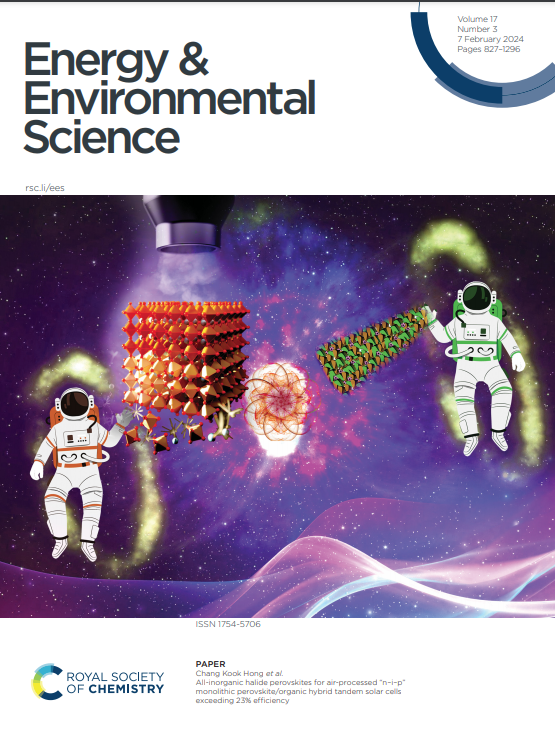Photon-coupled-proton buffers: reshaping solar-driven hydrogen and formic acid production with biomass
IF 30.8
1区 材料科学
Q1 CHEMISTRY, MULTIDISCIPLINARY
引用次数: 0
Abstract
Solar-driven selective biomass conversion presents a promising pathway for green hydrogen production. However, conventional approaches are hindered by solar intermittency and the challenge of balancing conversion efficiency with over-oxidation. Here, we design photon-coupled-proton buffers (PCPBs) based on heteropolyacids, integrating photosensitivity, proton storage, and redox modulation. Under illumination, the PCPB material H5SiVMo2W9O40·10H2O catalyzes glucose oxidation to formic acid while capturing protons via self-reduction to heteropolyblue. This proton-rich species can be electrolyzed at ultralow potentials (0.58/0.62 V vs. RHE at 50/100 mA cm−2) for on-site H2 production alongside PCPB self-regeneration. The system achieves 56.05% formic acid conversion from 0.1 M glucose and sustains H2 evolution (≥91 mL H2 per mmol glucose) over 14 cycles. Notably, the PCPB prototype delivers 82.44 g H2 per kg of glucose in aqueous solution—23.78% higher than the theoretical H2 output from aerobic glucose-to-formic acid conversion—surpassing conventional biomass photo-reforming. Furthermore, the PCPB is also effective for fructose, maltose, starch, and cellulose. Time-resolved spectroscopy and density functional theory (DFT) calculations reveal that Mo–Ob–W sites enable photon-coupled-proton transfer under illumination, suppressing over-oxidation through dynamic proton buffering. By reshaping the photocatalytic biomass valorization pathway, this approach provides a proof-of-concept for stable, transportable, and energy-efficient solar-H2 production.

光子耦合质子缓冲:重塑太阳能驱动的氢和甲酸生产与生物质
太阳能驱动的选择性生物质转化为绿色氢生产提供了一条有前途的途径。然而,传统的方法受到太阳能间歇性和平衡转换效率与过度氧化的挑战的阻碍。在这里,我们设计了基于杂多酸的光子耦合质子缓冲器(PCPBs),集成了光敏性,质子存储和氧化还原调制。在光照下,PCPB材料H5SiVMo2W9O40·10H2O催化葡萄糖氧化生成甲酸,同时通过自还原捕获质子生成杂多蓝。这种富含质子的物质可以在超低电位(0.58/0.62 V vs. RHE, 50/100 mA cm - 2)下电解,用于现场氢气生产和PCPB自我再生。该系统在0.1 M葡萄糖中实现56.05%的甲酸转化率,并在14个循环中维持H2的生成(≥91 mL H2 / mmol葡萄糖)。值得注意的是,PCPB原型在水溶液中每千克葡萄糖产生82.44 g氢气,比好氧葡萄糖转化为甲酸的理论氢气产量高出23.78%,超过了传统的生物质光转化。此外,PCPB对果糖、麦芽糖、淀粉和纤维素也有效。时间分辨光谱和密度泛函理论(DFT)计算表明,Mo-Ob-W位点能够在光照下实现光子耦合质子转移,通过动态质子缓冲抑制过度氧化。通过重塑光催化生物质增值途径,该方法为稳定、可运输和节能的太阳能- h2生产提供了概念验证。
本文章由计算机程序翻译,如有差异,请以英文原文为准。
求助全文
约1分钟内获得全文
求助全文
来源期刊

Energy & Environmental Science
化学-工程:化工
CiteScore
50.50
自引率
2.20%
发文量
349
审稿时长
2.2 months
期刊介绍:
Energy & Environmental Science, a peer-reviewed scientific journal, publishes original research and review articles covering interdisciplinary topics in the (bio)chemical and (bio)physical sciences, as well as chemical engineering disciplines. Published monthly by the Royal Society of Chemistry (RSC), a not-for-profit publisher, Energy & Environmental Science is recognized as a leading journal. It boasts an impressive impact factor of 8.500 as of 2009, ranking 8th among 140 journals in the category "Chemistry, Multidisciplinary," second among 71 journals in "Energy & Fuels," second among 128 journals in "Engineering, Chemical," and first among 181 scientific journals in "Environmental Sciences."
Energy & Environmental Science publishes various types of articles, including Research Papers (original scientific work), Review Articles, Perspectives, and Minireviews (feature review-type articles of broad interest), Communications (original scientific work of an urgent nature), Opinions (personal, often speculative viewpoints or hypotheses on current topics), and Analysis Articles (in-depth examination of energy-related issues).
 求助内容:
求助内容: 应助结果提醒方式:
应助结果提醒方式:


